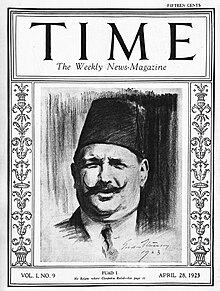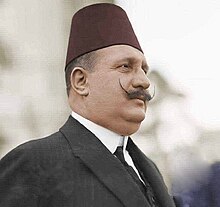Fuad I of Egypt
This article needs additional citations for verification. (April 2021) |
| Fuad I فؤاد الأول | |
|---|---|
Sultan of Egypt | |
| Successor | Farouk I |
| Prime Ministers | See list
|
King of Egypt | |
| Prime Ministers | See list
|
| Born | 26 March 1868 Giza Palace, Cairo, Khedivate of Egypt, Ottoman Empire |
| Died | 28 April 1936 (aged 68) Koubbeh Palace, Cairo, Kingdom of Egypt |
| Burial | |
| Consort | |
Isma'il I | |
| Mother | Ferial Qadin |
| Religion | Sunni Islam |

Fuad I (
Early life
Fuad was born in

Prior to becoming sultan, Fuad had played a major role in the establishment of
Reign
This section needs expansion. You can help by adding to it. (February 2010) |


Fuad came under consideration as a candidate for the Albanian throne, but he was ultimately bypassed in favour of a Christian ruler. He ascended the throne of the
The 1923 Constitution granted Fuad vast powers. He made frequent use of his right to dissolve Parliament. During his reign, cabinets were dismissed at royal will, and parliaments never lasted for their full four-year term but were dissolved by decree.[5]
Creation of the Royal Archives

Fuad was an instrumental force in modern Egyptian historiography. He employed numerous archivists to copy, translate, and arrange eighty-seven volumes of correspondence related to his paternal ancestors from European archives, and later to collect old documents from Egyptian archives into what became the Royal Archives in the 1930s. Fuad's efforts to portray his ancestors – especially his great-grandfather Muhammad Ali, his grandfather Ibrahim, and his father – as nationalists and benevolent monarchs would prove to be an enduring influence on Egyptian historiography.[6]
Personal life

Fuad married his first wife in Cairo, on 30 May 1895 (nikah), and at the
Fuad married his second wife at the Bustan Palace in Cairo on 24 May 1919. She was
.As with his first wife, Fuad's relation with his second wife was also stormy. The couple continually fought, Fuad even forbidding Nazli from leaving the palace. When Fuad died, it was said that the triumphant Nazli sold all of his clothes to a local used-clothes market in revenge. Fuad died at the Koubbeh Palace in Cairo and was buried at the Khedival Mausoleum in the ar-Rifai Mosque in Cairo.
King Fuad's wife lived as a widow after his death. She did not have good relations with her son. After Fuad's death, she left Egypt and went to the United States. She converted to Catholicism in 1950 and changed her name to Mary Elizabeth. She got deprived of her rights and titles in Egypt. Once named the world's richest and most elegant woman, she possessed one of the largest jewellery collections in the world.
China
The Fuad (Fū’ād) (فؤاد الأول) Muslim Library in China was named after him by the Chinese Muslim Ma Songting.[8] Muḥammad 'Ibrāhīm Fulayfil (محمد إبراهيم فليفل) and Muḥammad ad-Dālī (محمد الدالي) were ordered to Beijing by the King.[9]
Titles
- 26 March 1868 – 9 October 1917: His HighnessAhmed Fuad Pasha
- 9 October 1917 – 15 March 1922: His Highness The Sultan of Egypt and Sudan, Sovereign of Nubia, Kordofan and Darfur
- 15 March 1922 – 28 April 1936: His Majesty The King of Egypt and Sudan, Sovereign of Nubia, Kordofan and Darfur
Honours
- Domestic[citation needed]
- Founder and Sovereign of the Order of Agriculture
- Founder and Sovereign of the Order of Culture
- Founder and Sovereign of the Order of Commerce and Industry
- Foreign[citation needed]
- Ottoman Empire: Order of the Medjidie, 1st Class, 1893
- Kingdom of Italy: Grand Cross of the Order of Saints Maurice and Lazarus, 1911
- Greece: Grand Cross of the Order of the Redeemer, 1912
- United Kingdom of Great Britain and Ireland: Knight Grand Cross of the Order of the Bath (GCB), 1917
- Qajar Iran: Imperial Order of Persia, 1919
- Portugal: Grand Cross of the Order of the Tower and Sword, 1920[10]
- Sweden: Commander Grand Cross of the Order of Vasa, 1921
- Kingdom of Romania: Grand Cross w/Collar of the Order of Carol I, 1921
- Empire of Japan: Collar of the Order of the Chrysanthemum, 1921
- Kingdom of Italy: Knight of the Order of the Most Holy Annunciation, 1922
- Spain: Collar of the Order of Charles III, 1922[11]
- Kingdom of Hejaz: Grand Cordon of the Order of the Renaissance of the Hejaz, 1922
- Netherlands: Knight Grand Cross of the Order of the Netherlands Lion, 1925
- Kingdom of Afghanistan: Grand Collar of the Order of the Supreme Sun, 1927
- Albanian Kingdom: Grand Collar of the Kingdom of Albania, 1927
- United Kingdom: Royal Victorian Chain (RVC), 1927
- French Third Republic: Grand Cross of the Legion of Honour, 1927
- Belgium: Grand Cordon of the Order of Leopold, 1927
- Syria: Grand Cordon of the Order of the Umayyads, 1927
- Czechoslovakia: Collar of the Order of the White Lion, 1927
- Poland: Grand Cross of the Order of the White Eagle, 1932
- Sweden: Knight of the Royal Order of the Seraphim, 1933
- Thailand: Knight of the Order of the Royal House of Chakri, 1934
- Denmark: Knight of the Order of the Elephant, 1932
- Finland: Grand Cross of the Order of the White Rose of Finland, 1935
- Iran: Grand Collar of the Order of the Crown, 1935
See also
References
- General
- الملك أحمد فؤاد الأول [King Ahmad Fuad I] (in Arabic). Bibliotheca Alexandrina: Memory of Modern Egypt Digital Archive. Retrieved 27 February 2010.
- Specific
- OCLC 18496936.
- ISBN 978-977-424-554-1.
- OCLC 49549849.
- ^ "The Presidents of the Society". Egyptian Geographic Society. Archived from the original on 24 July 2011. Retrieved 27 February 2010.
- ISBN 978-977-416-199-5.
- ^ Khaled Fahmy, Mehmed Ali: From Ottoman Governor to Ruler of Egypt (Oxford: Oneworld Publications, 2009)
- ProQuest 305369852.
- ISBN 978-0-415-36835-3. Retrieved 28 June 2010.
- ISBN 978-90-04-14473-6.
- ^ "ENTIDADES ESTRANGEIRAS AGRACIADAS COM ORDENS PORTUGUESAS - Página Oficial das Ordens Honoríficas Portuguesas". ordens.presidencia.pt.
- ^ "Hemeroteca Digital. Biblioteca Nacional de España". hemerotecadigital.bne.es.
External links

